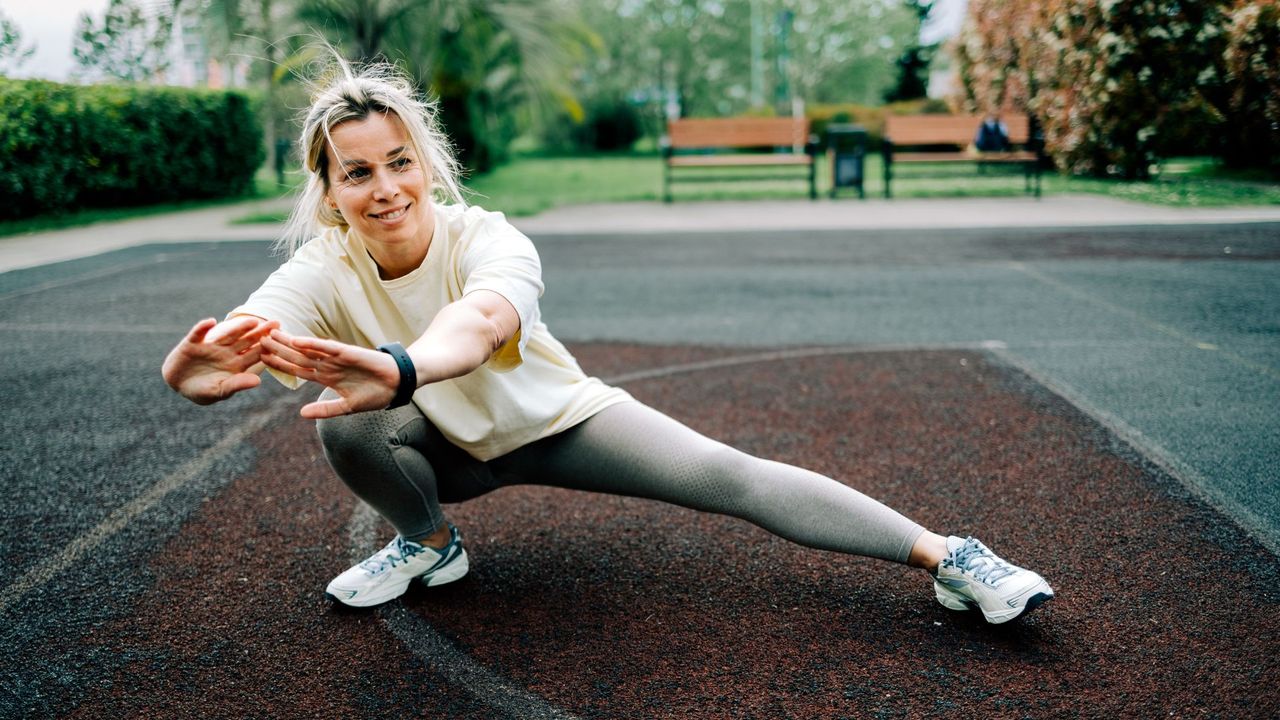
Functional fitness exercises include those that mirror real-life movements, such as squats, deadlifts, and walking lunges. A new report suggests that doing these can help athletes improve their overall fitness levels, but everyday people can benefit too.
The research considered 145 studies and found that functional training "significantly improved" speed, muscular strength, power, balance, and agility.
The studies examined different athlete types, including those from tennis, handball, and football, across men's and women's teams. They were also tested across a variety of strength training exercises, including plyometric (explosive movement), sprinting, balancing, and single-leg movements.
Even with the participants' high cardiovascular fitness and strength levels, these exercises made a difference.
While the study, published in Frontiers in Physiology, looks at athletes, there's every reason to think the same could apply to the everyday person. "In fact, for people who currently do little to no exercise, functional fitness can be especially beneficial," says Ian Groves, a certified personal trainer, strength specialist, and the managing director of Training Station.
"By regularly performing these movements, you'll quickly see improvements in everyday performance, mobility, and balance, while lowering your risk of injury," he says.
For those who already train with dumbbells and other weights, it can be a great way to maintain fitness levels while out of the gym or a regular exercise routine, whether that's for a busy period at work, a holiday, or just a break.
"The beauty of functional training is its adaptability," says Groves. "It can be tailored to your schedule, age and ability, which means almost everyone can benefit from adding it to their weekly routine."
Functional fitness exercises to try
1. Walking lunges
Walking lunges are a unilateral movement that helps with balance and strength, recruiting the help of your muscles to stabilise during the movement. As it goes from point A to point B, it’s a typical functional training exercise for its locomotion.
How to do walking lunges:
- Stand with your feet together, shoulder-width apart, and take a comfortable step forward with one foot.
- Bring your back knee down so it sits at a right angle to your front, creating a regular lunge position.
- Stabilise your upper body by bringing your shoulder blades back and down, as if you're trying to squeeze pencils between your armpits.
- Lift your back knee up and take a step forward over the front leg, repeating the movement.
- Try and bring your back knee as close to the ground as possible.
2. Single-leg squat
Squats are a great quadricep exercise, targeting the lower-body muscles, including the quads, hamstrings, and glutes. Add a little extra challenge with a single-leg movement, as this requires more balance, stability, and flexibility.
It was also one of the functional training methods included in the report.
How to do a single-leg squat:
- Stand with your feet shoulder-width apart, toes pointed forward.
- Brace your abs, lift one leg in front of you - or behind, whatever's easiest.
- Squat down on one leg as deep as you can.
- Pause for a moment at the bottom and make sure your knee is in line with your toe.
- Drive up from the heel of your foot.
- Repeat the exercise.
3. Box jumps
Box jumps are a polymetric exercise (explosive movement) that involves a quick vertical jump onto a soft box, landing in a squat.
Vertical ‘multi-level’ jumps were also included as a method of functional training in the report.
How to do box jumps:
- Face a bench or box (preferably designed for box jumps - in a gym, for example) with your feet shoulder width apart.
- Bend your knees and push your hips back, then jump with both feet onto the box.
- Make sure to swing your arms to give yourself more power and push from the balls of your feet.
4. Pull-ups
Pull-ups are thought of more for upper strength, but they include a strong pulling movement, which works as a functional exercise.
One of the studies in the review looked at pull-ups and “observed a significant improvement on [...] the back strength test” with muscular strength.
If you're not able to do a full pull-up yet, you can work towards it with a resistance band, as shown in the video.
How to do a pull-up with a resistance band:
- Loop the resistance band around the bar and at least one of your feet.
- Grip onto the bar and engage your core.
- Squeeze your shoulder blades together and pull yourself up, using the band for support.
- Keep going until your chin reaches above the bar.
- Hold this position for a moment.
- Lower yourself down in a controlled way.
5. Deadlifts
Compound movements that include reaching, bending, and locomotion are excellent functional training exercises. As you’re moving the hips backwards and forwards, there’s locomotion.
Deadlifts are one of the best functional glute exercises as they recruit most of the lower body muscles, and imitate lifting objects from the floor in everyday life.
How to do a deadlift:
- Stand in front of a barbell sitting on the floor.
- Step forward so your midfoot sits under the bar.
- Bend over and grab hold of the bar, making sure your hands sit shoulder-width apart.
- Bend your knees until your shins touch the bar.
- Straighten your back and lift your chest up.
- Leading with your chest, push from your heels and stand up with the weight.
Benefits of functional fitness exercises
- Life gets easier: The key benefit of functional fitness is that it mirrors normal life. "It trains the body to handle real-life movements with more ease and safety," says the personal trainer. "You'll move more efficiently and with less strain, whether you're carrying shopping bags up stairs or playing your favourite sport."
- Boosts core strength: While most functional exercises don't look like core exercises, they are actually some of the best core exercises and back exercises, as they target the deep core muscles - essential for reducing back pain, stabilising the spine, and improving posture.
- Improved mobility and flexibility: Many of us suffer from limited mobility with age, and functional fitness workouts, like callisthenics for beginners, can help prevent this. "Functional exercises target multiple joints and movement patterns, helping restore mobility, enhance balance, and maintain good posture," he says.
- Reduces injury risk: If you do another sport, whether that's tennis or cycling, functional fitness exercises are an essential element of training to prevent injuries as they boost strength in the surrounding muscles.
Is functional fitness the same as HIIT or CrossFit?
No, while functional fitness exercises like deadlifts are often found in CrossFit workouts and many HIIT classes include exercises like bodyweight squats, they are different in priority.
"CrossFit combines weightlifting, gymnastics, and conditioning in constantly varied workouts, usually performed for time or reps in a group setting, with the goal of boosting overall athletic performance," says Ian. "HIIT alternates short bursts of maximum effort with low-intensity recovery, and can include functional or non-functional exercises, but its main focus is improving cardiovascular fitness and burning calories quickly."







